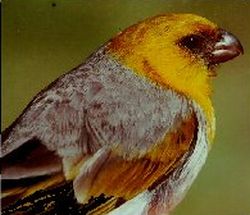Loxioides facts for kids
Quick facts for kids Loxioides |
|
|---|---|
 |
|
| Palila (L. bailleui) | |
| Scientific classification |
|
| Kingdom: | Animalia |
| Phylum: | Chordata |
| Class: | Aves |
| Order: | Passeriformes |
| Family: | Fringillidae |
| Subfamily: | Carduelinae |
| Genus: | Loxioides Oustalet, 1877 |
| Species | |
Loxioides is a special group of birds known as Hawaiian honeycreepers. These birds are found only in Hawaii, which means they are endemic to these beautiful islands. They are known for their unique beaks, which help them find different kinds of food.
Contents
Meet the Loxioides Birds
The birds in the Loxioides group are part of a larger family of birds called Carduelinae. This family includes many finches and other seed-eating birds. Hawaiian honeycreepers, like the Loxioides, are a very special part of Hawaii's wildlife. They have adapted over many years to live only on these islands.
These birds are important to the Hawaiian ecosystem. They help to spread seeds and pollinate plants, which keeps the forests healthy. Sadly, many Hawaiian honeycreepers are now endangered or have gone extinct. This makes the Loxioides birds that are still around even more precious.
Species of Loxioides
Today, only one species of Loxioides is still alive. However, scientists have found evidence of another species that lived a long time ago.
The Living Palila
The Palila is the only living species in the Loxioides group. It was first described by a scientist named Émile Oustalet in 1877. The Palila is famous for its bright yellow head and chest, with a gray back and white belly.
Palila birds live only on the slopes of Mauna Kea, a large volcano on the Big Island of Hawaii. They mostly eat the seeds of the mamane tree. Their strong beaks are perfect for cracking open the tough pods of these seeds. The Palila is an endangered species, meaning it is at high risk of disappearing forever. Efforts are being made to protect their habitat and help their numbers grow.
The Prehistoric Kauaʻi Palila
The Kauaʻi Palila is a species that lived in the past. It was discovered by scientists Helen James and Storrs Olson in 2006, based on fossils they found. This bird lived on the island of Kauaʻi.
Scientists believe the Kauaʻi Palila might have survived until the early 1700s. This means it could have been alive when the first Europeans arrived in Hawaii. Like its living cousin, the Kauaʻi Palila likely played an important role in the forests of Kauaʻi before it went extinct. Studying these ancient birds helps us understand how Hawaiian ecosystems have changed over time.

